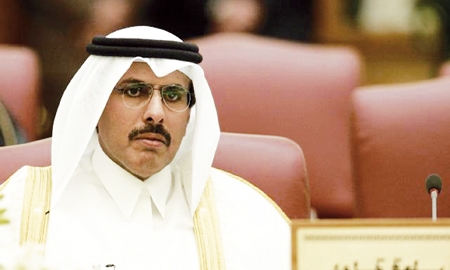Founded in 1973 and originally known as the Qatar Monetary Agency, the Qatar Central Bank (QCB) oversees the country’s financial fortunes.
Many factors have contributed to building the monetary safe haven that the State of Qatar is today. One of the most important has been the link between the Qatari Riyal and the US dollar. Sheikh Abdulla Saud Al Thani, Governor of the QCB, believes this attachment to the dollar has had a profound effect on creating the solid platform on which Qatar’s economy stands today.
“There are several advantages in maintaining the USD peg; first of all, the fixed exchange rate provides a credible anchor for monetary policy as almost all of Qatar’s export contracts and invoicing are done in the US dollar. Secondly, for most of the period in which the peg has been maintained, the Qatari economy has benefited from the stable economic environment in the US,” says the central bank governor.
Since 2001, QCB has maintained a policy of keeping the Qatari Riyal pegged to the US dollar, at an average exchange rate of 3.64 (QR) per USD. However, this is not the only action taken by the central bank, which is constantly studying new ways to fortify and stabilise Qatar’s economy.
“We continue to reiterate our faith in the pegged exchange rate regime [with the USD] after carefully weighing the benefits against the costs.”
Sheikh Abdulla Saud Al Thani,
Governor of the Qatar Central Bank
|
“Despite obvious benefits there are some challenges while operating under fixed exchange rates, as we have to maintain our stance of policy consistent with that of the US, which may not always be justified based on our own domestic considerations. We continue to reiterate our faith in the pegged exchange rate regime after carefully weighing the benefits against the costs. Nevertheless, we will continue to review the situation according to evolving international and domestic macroeconomic developments,” he adds.
Unlike many countries whose economies rely heavily on exports of natural resources, Qatar has been able to withstand market fluctuations in the prices for those products. The government’s national development strategy includes support for the expansion of non-hydrocarbon industries, so that in the case of a slowdown in the oil and gas sector, the economy will not be unduly affected. Right now, both areas of the economy are doing well – so much so that the central bank has even lowered interest rates to make credit more easily available to companies in the private sector.
“The non-hydrocarbon sector also recorded higher growth, indicating resurgence in economic activity during the year in sync with the pickup in global growth. In order to support and sustain the growth momentum in 2011, we have recently reduced our key policy rate by 50 basis points to signal a soft interest rate regime and encourage the flow of credit to the private sector,” says Sheikh Abdulla Saud Al Thani.
The government’s long-term vision is a cautious and careful one, which seeks to preserve financial stability through a two-pronged approach. To date, this strategy has been highly successful.
The first aspect of the policy is to prevent the financial system from exposure to unnecessarily high levels of risk. To this end, the QCB has taken preventive measures to regulate and supervise the system, so that any weaknesses can be detected early on. Even with extensive supervision, however, no financial system can be completely protected from all types of risk. For this reason, the second axis of the policy is corrective, as it seeks to contain any problems at the earliest possible moment and in so doing, prevent them from spreading.
The central bank has also taken preventive steps to limit the banking sector’s exposure in real estate and in stocks. Rising prices in both these areas during the past two years have increased speculative investment. As a result, restrictions have been placed on loans in the real estate sector and financing of stock purchases has been prohibited. With measures like these, the Qatar Central Bank seeks to maintain equilibrium between the country’s development goals and its need to maintain a stable financial system.
In order for investors to make long-term commitments in productive sectors, they require economic stability. Even so, all countries eventually find themselves exposed to crises, long- or short-term fluctuations in export prices or even situations of extreme financial distress that can adversely affect economic activity.
Stability is the watchword for the Qatar Central Bank and the proof is in the results of its policies. QCB keeps a close watch on all potential dangers to the country’s banking system; to date, it has published three Financial Stability Reviews and the intention is to make this a continuing process.

0 COMMENTS